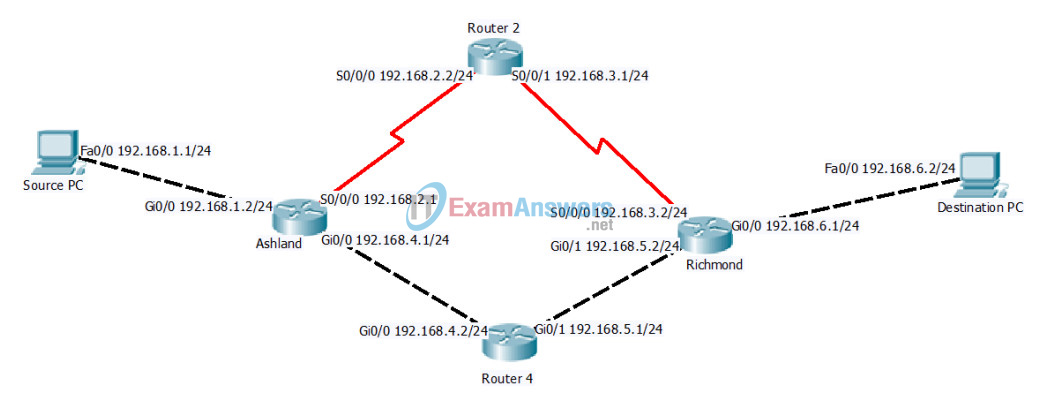1.4.1.1 We Really Could Use a Map! (Instructor Version – Optional Lab)
Instructor Note: Red font color or gray highlights indicate text that appears in the instructor copy only. Optional activities are designed to enhance understanding and/or to provide additional practice.
Objectives
Describe the three types of routes that are populated in a routing table (to include: directly-connected, static, and dynamic).
This modeling activity should help students feel more comfortable with reading a routing table. Two router tables will be presented to the students – they will read the tables, identify routing information, and reflect on how information was recorded in the table).
Scenario
Use the Ashland and Richmond routing tables shown below. With the help of a classmate, draw a network topology using the information from the tables. To assist you with this activity, follow these guidelines:
- Start with the Ashland router – use its routing table to identify ports and IP addresses/networks.
- Add the Richmond router – use its routing table to identify ports and IP addresses/networks.
- Add any other intermediary and end devices, as specified by the tables.
In addition, record answers from your group to the reflection questions provided with this activity.
Be prepared to share your work with another group or the class.
Resources
Ashland> show ip route Codes: L - local, C - connected, S - static, R - RIP, M - mobile, B - BGP D - EIGRP, EX - EIGRP external, O - OSPF, IA - OSPF inter area N1 - OSPF NSSA external type 1, N2 - OSPF NSSA external type 2 E1 - OSPF external type 1, E2 - OSPF external type 2, E - EGP i - IS-IS, L1 - IS-IS level-1, L2 - IS-IS level-2, ia - IS-IS inter area * - candidate default, U - per-user static route, o - ODR P - periodic downloaded static route Gateway of last resort is not set 192.168.1.0/24 is variably subnetted, 2 subnets, 2 masks C 192.168.1.0/24 is directly connected, GigabitEthernet0/1 L 192.168.1.1/32 is directly connected, GigabitEthernet0/1 192.168.2.0/24 is variably subnetted, 2 subnets, 2 masks C 192.168.2.0/24 is directly connected, Serial0/0/0 L 192.168.2.1/32 is directly connected, Serial0/0/0 D 192.168.3.0/24 [90/2170368] via 192.168.4.2, 01:53:50, GigabitEthernet0/0 192.168.4.0/24 is variably subnetted, 2 subnets, 2 masks C 192.168.4.0/24 is directly connected, GigabitEthernet0/0 L 192.168.4.1/32 is directly connected, GigabitEthernet0/0 D 192.168.5.0/24 [90/3072] via 192.168.4.2, 01:59:14, GigabitEthernet0/0 S 192.168.6.0/24 [1/0] via 192.168.2.2 Ashland>
Richmond> show ip route Codes: L - local, C - connected, S - static, R - RIP, M - mobile, B - BGP D - EIGRP, EX - EIGRP external, O - OSPF, IA - OSPF inter area N1 - OSPF NSSA external type 1, N2 - OSPF NSSA external type 2 E1 - OSPF external type 1, E2 - OSPF external type 2, E - EGP i - IS-IS, L1 - IS-IS level-1, L2 - IS-IS level-2, ia - IS-IS inter area * - candidate default, U - per-user static route, o - ODR P - periodic downloaded static route Gateway of last resort is not set S 192.168.1.0/24 [1/0] via 192.168.3.1 D 192.168.2.0/24 [90/2170368] via 192.168.5.2, 01:55:09, GigabitEthernet0/1 192.168.3.0/24 is variably subnetted, 2 subnets, 2 masks C 192.168.3.0/24 is directly connected, Serial0/0/0 L 192.168.3.2/32 is directly connected, Serial0/0/0 D 192.168.4.0/24 [90/3072] via 192.168.5.2, 01:55:09, GigabitEthernet0/1 192.168.5.0/24 is variably subnetted, 2 subnets, 2 masks C 192.168.5.0/24 is directly connected, GigabitEthernet0/1 L 192.168.5.1/32 is directly connected, GigabitEthernet0/1 192.168.6.0/24 is variably subnetted, 2 subnets, 2 masks C 192.168.6.0/24 is directly connected, GigabitEthernet0/0 L 192.168.6.1/32 is directly connected, GigabitEthernet0/0 Richmond>
Reflection
1. How many directly connected routes are listed on the Ashland router? What letter represents a direct connection to a network on a routing table?
__________________________________________________
There are three direct connections on the Ashland router, as represented by the letter C.
2. Find the route to the 192.168.6.0/24 network. What kind of route is this? Was it dynamically discovered by the Ashland router or manually configured by a network administrator on the Ashland router?
__________________________________________________
The route from Ashland to 192.168.6.0/24 network is a static route and was manually configured.
3. If you were configuring a default (static route) to any network from the Ashland router and wanted to send all data to 192.168.2.2 (the next hop) for routing purposes, how would you write it?
Ashland(config)# ip route 0.0.0.0 0.0.0.0 192.168.2.2
4. If you were configuring a default (static route) to any network from the Ashland router and wanted to send all data through your exit interface, how would you write it?
Ashland(config)# ip route 0.0.0.0 0.0.0.0 S0/0/0
5. When would you choose to use static routing, instead of letting dynamic routing take care of the routing paths for you?
__________________________________________________
If a router has a very reliable port to use, you may wish to route all traffic through (or to) that port, as this decreases processing load on the router. Also, sometimes network administrators will route traffic to certain network through certain ports to secure their networks.
6. What is the significance of the L on the left side of the routing table?
________________________________________________
It indicates the “link local” address of the port on the router which is configured by the network administrator.
Modeling Activity Graphic Representation (Instructor Resource Only)
Instructor Note: This is an example model that might be “built” as a result of this activity:

Identify elements of the model that map to IT-related content:
- Routes
- Routing Table
- Exit Interface
- Next Hop Interface
- Static Route
- Default Routing
- Static Routing
- Dynamic Routing
- Link Local
